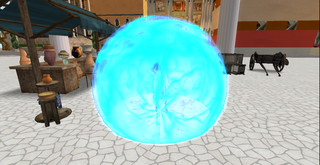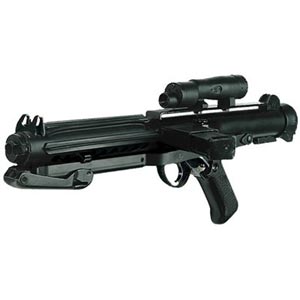
The Boeing YAL-1 Airborne Laser Testbed weapons system was a megawatt-class chemical oxygen iodine laser (COIL) mounted inside a modified military Boeing 747-400F. It was primarily designed as a missile defense system to destroy tactical ballistic missiles (TBMs) while in boost phase. The aircraft was designated YAL-1A in 2004 by the U.S. Department of Defense.
The Joint Direct Attack Munition (JDAM) is a guidance kit that converts unguided bombs, or "dumb bombs", into all-weather precision-guided munitions. JDAM-equipped bombs are guided by an integrated inertial guidance system coupled to a Global Positioning System (GPS) receiver, giving them a published range of up to 15 nautical miles (28 km). JDAM-equipped bombs range from 500 pounds (230 kg) to 2,000 pounds (910 kg). The JDAM's guidance system was jointly developed by the United States Air Force and United States Navy, hence the "joint" in JDAM. When installed on a bomb, the JDAM kit is given a GBU identifier, superseding the Mark 80 or BLU nomenclature of the bomb to which it is attached.

In speculative fiction, a force field, sometimes known as an energy shield, force shield, force bubble or deflector shield, is a barrier made of things like energy, negative energy, dark energy, electromagnetic fields, gravitational fields, electric fields, quantum fields, plasma, particles, radiation, solid light, or pure force. It protects a person, area, or object from attacks or intrusions or even deflects energy attacks back at the attacker. This fictional technology is created as a field of energy without mass that acts as a wall, so that objects affected by the particular force relating to the field are unable to pass through the field and reach the other side, are deflected or destroyed. Actual research in the 21st century has looked into the potential to deflect radiation or cosmic rays, but also more extensive shielding.

Strange and exotic weapons are a recurring feature in science fiction. In some cases, weapons first introduced in science fiction have been made a reality; other science-fiction weapons remain purely fictional, and are often beyond the realms of known physical possibility.

A directed-energy weapon (DEW) is a ranged weapon that damages its target with highly focused energy, including lasers, microwaves, particle beams, and sound beams. Potential applications of this technology include weapons that target personnel, missiles, vehicles, and optical devices. In the United States, the Pentagon, DARPA, the Air Force Research Laboratory, United States Army Armament Research Development and Engineering Center, and the Naval Research Laboratory are researching directed-energy weapons to counter ballistic missiles, hypersonic cruise missiles, and hypersonic glide vehicles. These systems of missile defense are expected to come online no sooner than the mid to late-2020s.

The McDonnell DouglasF-15E Strike Eagle is an American all-weather multirole strike fighter derived from the McDonnell Douglas F-15 Eagle. The F-15E was designed in the 1980s for long-range, high-speed interdiction without relying on escort or electronic-warfare aircraft. United States Air Force (USAF) F-15E Strike Eagles can be generally distinguished from other US Eagle variants by darker aircraft camouflage, conformal fuel tanks (CFTs) mounted along the engine intake ramps and a tandem-seat cockpit.
The Active Denial System (ADS) is a non-lethal directed-energy weapon developed by the U.S. military, designed for area denial, perimeter security and crowd control. Informally, the weapon is also called the heat ray since it works by heating the surface of targets, such as the skin of targeted human beings. Raytheon had marketed a reduced-range version of this technology. The ADS was deployed in 2010 with the United States military in the Afghanistan War, but was withdrawn without seeing combat. On August 20, 2010, the Los Angeles Sheriff's Department announced its intent to use this technology to control incarcerated people in the Pitchess Detention Center in Los Angeles, stating its intent to use it in "operational evaluation" in situations such as breaking up prisoner fights. As of 2014, the ADS was only a vehicle-mounted weapon, though U.S. Marines and police were both working on portable versions. ADS was developed under the sponsorship of the Department of Defense Non-Lethal Weapons Program with the Air Force Research Laboratory as the lead agency. There are reports that Russia and China are developing their own versions of the Active Denial System.

A blaster is a fictional gun that appears in the Star Wars universe. Lucasfilm defines the blaster as "ranged energized particle weaponry". Many blasters mirror the appearance, functions, components, operation, and usage of real life firearms. They are also said to be able to be modified with certain add-ons and attachments, with Han Solo's blaster being said to be illegally modified to provide greater damage without increasing power consumption.

The Advanced Tactical Laser (ATL) program was a US military program to mount a high energy laser weapon on an aircraft, initially the AC-130 gunship, for use against ground targets in urban or other areas where minimizing collateral damage is important. The laser was a 100 kilowatt-class chemical oxygen iodine laser (COIL). It was expected to have a tactical range of approximately twenty kilometres and weigh about 5,000–7,000 kg. This program is distinct from the Airborne Laser, which was a much larger system designed to destroy enemy missiles in the boost phase.

A guided bomb is a precision-guided munition designed to achieve a smaller circular error probable (CEP).

The HLONS , commonly known as ZEUS, is a solid-state laser weapon which is used by the U.S. military in order to neutralize surface land mines and unexploded ordnance. The ZEUS-HLONS system was a co-operative effort between Sparta Inc and NAVEODTECHDIV to demonstrate that a moderate-power commercial solid state laser (SSL) and beam control system could be integrated onto a Humvee (HMMWV) and used to clear surface mines, improvised explosive devices (IEDs), or unexploded ordnance from supply routes and minefields.

A laser weapon is a directed-energy weapon based on lasers. After decades of R&D, as of January 2020 directed-energy weapons including lasers are still at the experimental stage and it remains to be seen if or when they will be deployed as practical, high-performance military weapons. Atmospheric thermal blooming has been a major problem, still mostly unsolved, and worsened if fog, smoke, dust, rain, snow, smog, foam, or purposely dispersed obscurant chemicals are present. Essentially, a laser generates a beam of light which needs clear air, or a vacuum, to work without thermal blooming.

The AGR-20 Advanced Precision Kill Weapon System (APKWS) is a design conversion of Hydra 70 unguided rockets with a laser guidance kit to turn them into precision-guided munitions (PGMs). APKWS is approximately one-third the cost and one-third the weight of the current inventory of laser-guided weapons, has a lower yield more suitable for avoiding collateral damage, and takes one quarter of the time for ordnance personnel to load and unload.

The Boeing NC-135 and NKC-135 are special versions of the Boeing C-135 Stratolifter and Boeing KC-135 Stratotanker modified to operate on several different programs.

The 417th Flight Test Squadron is an active United States Air Force squadron. It is assigned to the 96th Operations Group at Eglin Air Force Base, Florida, where it was reactivated on 17 April 2019.

A precision-guided munition is a guided munition intended to precisely hit a specific target, to minimize collateral damage and increase lethality against intended targets. During the First Gulf War guided munitions accounted for only 9% of weapons fired, but accounted for 75% of all successful hits. Despite guided weapons generally being used on more difficult targets, they were still 35 times more likely to destroy their targets per weapon dropped.
The Iraq War documents leak is the disclosure to WikiLeaks of 391,832 United States Army field reports, also called the Iraq War Logs, of the Iraq War from 2004 to 2009 and published on the Internet on 22 October 2010. The files record 66,081 civilian deaths out of 109,000 recorded deaths. The leak resulted in the Iraq Body Count project adding 15,000 civilian deaths to their count, bringing their total to over 150,000, with roughly 80% of those civilians. It is the biggest leak in the military history of the United States, surpassing the Afghan War documents leak of 25 July 2010.

The GBU-39/B Small Diameter Bomb (SDB) is a 250 lb (110 kg) precision-guided glide bomb that is intended to provide aircraft with the ability to carry a higher number of more accurate bombs. Most US Air Force aircraft will be able to carry a pack of four SDBs in place of a single 2,000 lb (907 kg) bomb.
Applied Research Associates, Inc is a research and engineering company headquartered in Albuquerque, New Mexico, founded in 1979. As of 2018, its revenue was estimated at between $100 and $750 million by The Washington Post. As of 2011, it had approximately 1,600 employees.















